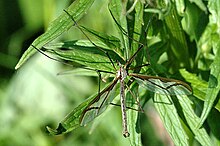| Pediciidae Temporal range: | |
|---|---|
 | |
| Pedicia rivosa | |
| Scientific classification | |
| Domain: | Eukaryota |
| Kingdom: | Animalia |
| Phylum: | Arthropoda |
| Class: | Insecta |
| Order: | Diptera |
| Infraorder: | Tipulomorpha |
| Superfamily: | Tipuloidea |
| Family: | Pediciidae Osten-Sacken, 1859 |
| Subfamilies | |
The Pediciidae or hairy-eyed craneflies are a family of flies closely related to true crane flies, with about 500 species worldwide.